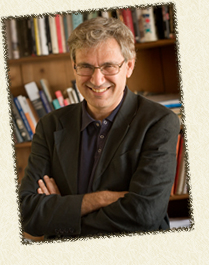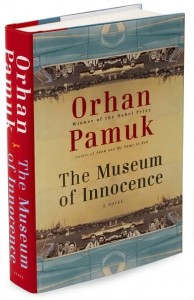 Like most of us, Orhan Pamuk‘s narrator Kemal rushes through his happiest moments in a preoccupied haze, only appreciating them in hindsight. A true materialist, he seeks to recreate them through his collections of mementos large and small, iconic and insignificant. His “museum” in The Museum of Innocence (Knopf, 2009/trans. Maureen Freely) is a diorama not only of Kemal’s own nostalgia, but of Turkey itself in the late 1970s.
Like most of us, Orhan Pamuk‘s narrator Kemal rushes through his happiest moments in a preoccupied haze, only appreciating them in hindsight. A true materialist, he seeks to recreate them through his collections of mementos large and small, iconic and insignificant. His “museum” in The Museum of Innocence (Knopf, 2009/trans. Maureen Freely) is a diorama not only of Kemal’s own nostalgia, but of Turkey itself in the late 1970s.
When we read novels, particularly from such a national icon as Pamuk, it’s common to expect the country and culture to express their conflict in the individual characters. Kemal, while embodied–and embroiled–within the double standards and hypocrisies of a semi-Westernized Turkey, is engaging enough to avoid the status of a ’70s-era Turkish Everyman. There’s something eccentric about him from the beginning: even while speaking of his youth, he has the quality of an old man who wants to show you the odds and ends he carries in his pockets. Kemal may just be the moodiest, most depressed young playboy in all of Istanbul’s ruling class.
Given the affluence he’s born into, it’s fitting that Kemal finds consolation in the material; from the very beginning, his life is choked with things. From the spare apartment, home to his affair with the younger Füsun, and used by Kemal’s mother as a storage unit, to Kemal’s opulent engagement party at the Istanbul Hilton, to the designer boutiques–real and counterfeit–the characters define themselves through what they wear, what they drink, and what they scorn. Full of skirts and earrings and champagne and scent, the book is a veritable bazaar of women and their possessions. The only exhaustible commodity seems to be virginity, and Kemal has disburdened two women of that weighty possession: on one hand, his fiancee, Sibel’s, and on the other, eighteen-year-old Füsun’s.
Kemal escalates the affair while drifting along in his public obligations toward Sibel, his approved match and his equal in social stature. At this point in Turkish history, upper-class women can call themselves “modern” for sleeping with their fiances once the men have been sufficiently cornered into making a public engagement. Sibel has been openly “living together” with Kemal, and he’s all but bought the cow when his affair with his distant relation Füsun begins. Füsun gives up her virginity to him with little fanfare, so much so that Kemal is incredulous that she was a virgin at all. Her enjoyment of their shared sexuality is unselfconscious and full-bodied but, hidden as their affair is, Kemal has no means or intention of repaying her “gift” to him. The socially endorsed Sibel, like a Western woman, sleeps with him out of love; Füsun is “modern and courageous,” a daredevil whom he promises nothing but the adventure of the affair.
We’re never quite sure what it is about Füsun that makes her so unforgettable–yes, she’s young and beautiful, but she flatters aging socialites all day at the Sanzelize boutique, fails her university entrance exams, and ultimately becomes a chain-smoking, though still beautiful, housewife. A potential answer might be found in an anecdote Kemal shares with us about himself as a youth with his distant cousin Füsun, twelve years younger, when they go out together, by chance, on an errand. They watch a lamb being sacrificed, and Kemal engages his driver in a discussion of Abraham’s sacrifice of his son. On the way back, the three find their discussion interrupted by a grisly car accident. Amid the blood and entrails of this scene, perhaps we are to understand that “little Füsun” internalized something of sacrifice and its workings: the yielding of something dear to a beloved, simply because he or she wishes it.
In tracing Füsun from her earliest appearance as a bump on her seamstress mother’s stomach, Kemal seems almost to be reproaching himself for the faint imprint she has had on his life to date. Once their affair begins, he focuses on her to the exclusion of almost all else, even at his own engagement party. Füsun eventually gives up and goes missing and, deprived of his honest, uncomplicated love, Kemal falls into a depression and loses Sibel and, ultimately, many of his friends. Bereft of its object, his obsession intensifies, and Kemal recedes from his visible, mappable life in Nisantasi to track Füsun, with some difficulty, to her family’s ramshackle, serpentine street in Çukurcuma.
Here, we are reminded of another anecdote: this time Kemal’s father’s. Having described his very young, very beautiful mistress, the older man describes how he “kept her dangling for years” only to find, after she broke off the affair, that she had died of cancer. He presents Kemal with a pair of pearl earrings that he had intended to give his mistress, urging him to give them to Sibel. He presents them to Füsun instead, who refuses them. In this action, we see her unknowing attempt to reject the fate of the kept woman before her. Throughout the novel, there are several such anecdotes of “kept” women: from Belkis, the notorious mistress-to-the-wealthy who dies alone, to the Turkish film stars who are “ruined” in the course of their work. We aren’t privy to much of Füsun’s inner life, but these stories must have been very much a part of her consciousness.
As Çukurcuma sweeps like a beaded curtain over his old life, Kemal finds that the real business of living occurs far from Istanbul’s landmarks and brand name-stamped thoroughfares. From Füsun’s family, he learns the homely pleasure of “sitting together” after dinner, allowing the television to wash over them and bond them with its flickering glow. Ironically, as Kemal retreats from the glitzy materialism of his own class, he becomes ever more attached to objects embodying the guileless love he shared with Füsun. From under her parents’–and philistine husband’s–noses, he filches lipstick kisses on tissues, almanac pages, hairpins, and cigarette butts, all with the fanaticism of the fetishist or frotteur.
When rekindling the affair becomes impossible, Kemal travels to Paris, which he had dreamed of visiting with Füsun. He loses himself “not in the Louvre or the Beaubourg, or the other crowded, ostentatious museums of that ilk,” but in the small, eclectic museums off the beaten path, on streets similar, perhaps, to the ones he traveled to get to Füsun’s family home. Perhaps finding a quiet community in the obsessions of other collectors, he visits private museums throughout the world, and is inspired to create his own monument to the love he shared with Füsun. As he supplements his collection with the objects that surrounded the brief era of their affair, he meets ever-more-introverted collectors devoted slavishly to one object or another. It is a testament to the souls of objects how ticket stubs, tin cans, restaurant menus, and ad circulars can resurrect for Kemal this lost era. Items that Kemal never noticed during the affair take on a deep significance for composing the background of his weeks of happiness–and for their encoding of the cultural referents that contained and shaped the affair itself. What better object than a Meltem soda ad featuring the German model Inge to illustrate Turkey’s attitude toward its own women?
Füsun is not a feminist icon, but she is a casualty of the Turkish femininity of her era. Seeking the fabled “loose women” who sleep with men for fun, Kemal’s friends visit brothels, while lower-class scoundrels cruise the streets harassing young girls. Some married upper-class men lose respect for their wives for “giving in” during the engagement. Kemal himself, presented with two deflowered women, chooses the one to whom he is publicly obligated and spends a lifetime regretting his choice. Ironically, his “Museum of Innocence” is a monument to his own culpability: the objects, so copious in number and so meticulously arranged, don’t add up to what he has lost through his own passivity.
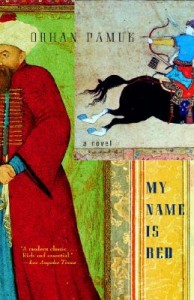
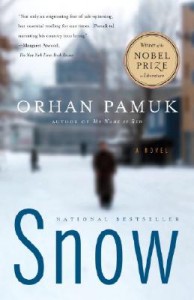
More linear than Pamuk’s novels My Name Is Red or Snow, The Museum of Innocence is more personal, as well as more lyrical. Perhaps because the plot engages in fewer gymnastics, the characters’ feelings of entrapment and loss are more potent. Though the sheer amount of research that must have gone into a book of this depth deserves respect in itself, this volume is not merely interesting as a relic of a bygone Turkey. In fact, it is Pamuk’s historic and cultural specificity that demonstrates to us that, whatever our historical moment, there will always be circumstances that make one choice easier than another. Just as Kemal both follows the path of least resistance in proceeding with his engagement to Sibel while continuing his affair with Füsun, we resent the forked path, sometimes denying that any action is necessary at all.
Despite the sea of botched affairs and ruined women, Pamuk displays no contempt for his subjects. It’s human, after all, to want to preserve our options for as long as possible: perhaps Kemal imagined a future where Füsun would somehow content herself with meeting him on the sly while he went through the motions in his marriage to Sibel. For as long as both possibilities existed, Kemal remained committed to inertia, more than to either woman. Like Schrodinger’s cat, he hoped to keep all of his potential futures alive for as long as he could maintain his uncertainty. We can’t admire Kemal for choosing inertia over action, but we can relate: who isn’t seduced by the untouched, open-ended future? Who wants to open the box and find that the cat is dead?
Extras
– Via UC Television/YouTube, An Evening with Orhan Pamuk at UC-Santa Barbara:
– At BarnesandNoble.com, read an excerpt from The Museum of Innocence. Here’s another excerpt via Magnificent Octopus.
– If you’re shopping for a copy of The Museum of Innocence, click here to buy from your favorite indie bookstore.
– In 2006, Orhan Pamuk was awarded the Nobel Prize in Literature. Learn more about his other books at Pamuk’s website, which also features a gallery of terrific author photos and links to many interviews with him and reviews of his work.
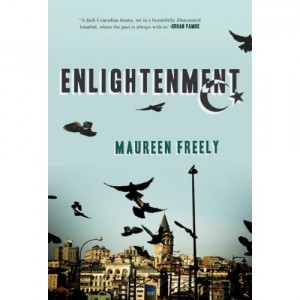 – The Museum of Innocence was translated into English by Maureen Freely, whose own impressive debut novel, Enlightenment, was previously reviewed by Natalie on FWR. In this Washington Post article and audio interview, Freely discusses the art of translating and interpreting Pamuk’s fiction.
– The Museum of Innocence was translated into English by Maureen Freely, whose own impressive debut novel, Enlightenment, was previously reviewed by Natalie on FWR. In this Washington Post article and audio interview, Freely discusses the art of translating and interpreting Pamuk’s fiction.

